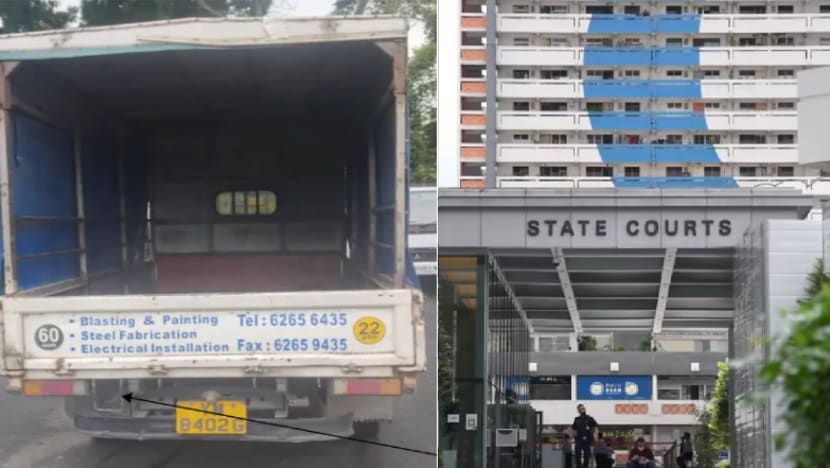Foreign worker sues company for S$100,000 in damages after fracturing leg alighting from overcrowded lorry
The director of the company had admitted that he had not "addressed his mind" on the safety of the workers when boarding or alighting from the lorry.

(Left) The lorry that the plaintiff reportedly fell from. (Photos: Court documents, Mediacorp)
SINGAPORE: A man who fractured his leg while alighting from a lorry that was ferrying 24 workers sued his company for damages over its negligence, saying the firm had failed to provide a safe system of alighting from the lorry or any safe system to transport workers.
In a judgment made available on Thursday (Aug 17), District Judge Tan May Tee ruled in favour of the worker, Mr Ramalingam Murugan, with damages to be assessed at a later stage.
In response to queries from CNA, Mr Murugan's lawyer Mr Muhamad Ashraf Syed Ansarai said his client was seeking about S$100,000 (US$73,400) in damages.
The judge ruled that a safe system of work is required, even for boarding and alighting from a lorry. The previous position was that this was a simple task that did not require any safe system of work, said Mr Muhamad Ashraf.
Mr Murugan, a 37-year-old Indian national, was working as a structural steel and ship painter for marine vessel repair company Rigel Marine Services at the time of the accident on Jan 3, 2021.
At around 7am that day, Mr Murugan was being transported from his dormitory to his company premises at 11A Joo Yee Road in the back of a 12-foot lorry with other workers.
The workers were to alight when they got to the worksite. They would then be transferred to another lorry and ferried to a work location.
It was raining heavily at the time, and the workers were in a hurry to shift to the other lorry so they would be sheltered from the rain, said Mr Murugan.
He was the fourth man to alight from the lorry. At the time, the tailboard of the vehicle was not lowered, so he used both his hands to hold onto it.
He then used his left leg to step over the tailboard, so he could place it on a foothold on the lorry. However, Mr Murugan said that he was pushed either by a co-worker or co-workers who were waiting to alight.
He lost his balance and fell to the ground. Upon hitting the ground with full impact, his knee swelled up. His colleagues carried him to a workshop at the site before he was taken back to his dorm.
He was later taken to the hospital when the pain failed to subside, and it was discovered that he had suffered a fracture in his right leg.
He underwent surgical treatment for the fracture and was on medical leave for about five months.
Mr Murugan, who was represented by Mr Muhamad Ashraf and Mr Perumal Athitham of Yeo Perumal Mohideen Law Corporation, sued his company, saying that the accident was caused by its negligence or breach of duty.
He claimed that the company and its employees had failed to provide him with safe access to and from the lorry, a safe system of alighting from the lorry or active supervision of the alighting process, and failed to institute or enforce any safe system of transport for the workers.
He also claimed that the company had failed to provide anyone to supervise and ensure safe alighting, or to carry out a risk assessment to identify the potential hazards associated with alighting from the vehicle.
THE COMPANY'S CASE
The company, which was defended by Mr Lennon Wu Leong Chong from Tan Kok Quan Partnership, denied the claims and said that Mr Murugan had slipped and fallen as he was making his way down from the lorry.
The company said the accident was caused or contributed by Mr Murugan's own carelessness in failing to watch his footing or step before alighting.
It also counterclaimed for the medical expenses and medical leave wages that had been paid to and for Mr Murugan.
The company claimed it was not raining the day of the incident, and that the other workers were not in a rush to alight as it was early in the morning.
The tailboard of the lorry was also not lowered as it would prevent alighting workers from placing their feet on the step at the back of the lorry, which helped them alight smoothly.
Based on the evidence, the judge found that it was "not inconceivable" that Mr Murugan could have been accidentally pushed, with 20 men standing up from their seats on both sides of the lorry and eager to get off.
"As can be seen from the marking on the tailboard, this lorry was not meant to carry more than 22 persons at the time so there appears to have been some overcrowding as well," she said.
She said the company could easily have disproved Mr Murugan's account by calling other workers to testify, and drew an adverse inference from the fact that it did not.
The company said that lorries were used to transport workers to their destination, with workers sitting in the back. It was not normal for the tailboard to be lowered for alighting as doing so would block the foothold.
The company submitted that no supervision was required as "the process of workers alighting from the lorry is so simple and straightforward".
To put supervisors for such a simple process would impose an excessive obligation on the employer, it said.
The company added that an employer "is not required to constantly supervise every minute detail and work process of the employee", especially when Mr Murugan was an experienced worker who had 15 years of experience in Singapore's construction industry.
JUDGE'S FINDINGS
The judge disagreed with the company's submissions.
Without lowering the tailboard, the process of alighting from the deck of the lorry "effectively required a worker to execute an acrobatic move by having to hoist one leg over the tailboard to lower himself at a height of more than one metre and then swing his other leg over to the ground", said Judge Tan.
Most able-bodied workers might easily accomplish this, but "it is certainly not without risks, as this accident has amply demonstrated", she said.
"Without proper supervision and the maintenance of some order or discipline in alighting, the plaintiff had been pushed by his co-workers, which resulted in him losing his balance and falling," said the judge.
"I therefore find that there was no proper and safe system in place for the safe access and/or egress from the deck of the lorry at the material time."
She also noted that the director of the company had admitted under cross-examination that he had not "addressed his mind" on the safety of the workers when they were boarding or alighting.
He also agreed that he "never had a safe procedure for transporting workers in numbers", nor instituted or enforced any safe system for transporting his workers.
The judge found that there was clearly a breach of duty by the company in failing to put in place a system of safe access to and from the lorry deck. This caused the accident leading to Mr Murugan's injuries, she said.
The director testified that after that accident, the company had realised that a risk assessment for boarding and alighting from the lorry was needed.
The judge found no contributory negligence on the part of Mr Murugan, as he had fallen as a result of being pushed and there was no way for him to avoid the accident.
Damages will be assessed at the next stage.

















